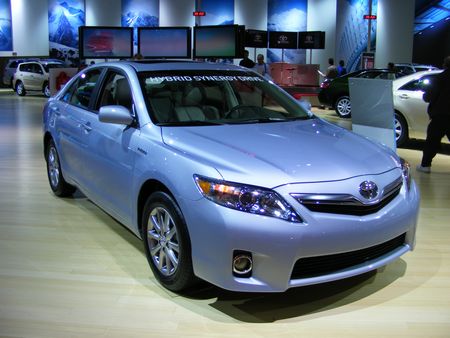Friday, January 1, 2010
Toyota Camry 2010
Some things don't change. Take the 2010 Toyota Camry's buttery-soft ride and roomy, serene cabin, for example, which have been endearing Camry traits since we can remember. And some things get better with age. Look at the Camry's powerful, fuel-efficient and ultra-smooth 268-horsepower V6, which is not only the best Camry V6 ever, but also the best all-around V6 in any family sedan. Unfortunately, other things can sour with time. That's where the current Camry's underwhelming interior quality comes in. Overall, though, the 2010 Camry remains one of the top choices in this competitive segment. With excellent crash test scores and comfort and refinement to spare, the Camry's got what most family-sedan shoppers want.
For 2010, the Camry receives a midcycle rejuvenation. Most notably, the base four-cylinder engine increases in size from 2.4 to 2.5 liters, with a corresponding 11-hp bump (21 hp on the SE), and the manual and automatic transmissions matched to this engine are now blessed with six gears instead of five. The exterior styling has also been tweaked, boasting a new grille, larger headlights, and a revised taillight design. On the safety front, stability control is now standard across the lineup. Other notable additions include auto up/down windows all around and a new optional audio system with satellite radio and Bluetooth for the lower trim levels.
The current-generation Camry's '07 debut coincided with the latest Nissan Altima's, and the new Honda Accord joined the crowd a year later. Then, in 2009, Mazda threw its hat in the ring with the upsized Mazda 6. Meanwhile, other competent midsizers like the Chevrolet Malibu and Hyundai Sonata have soldiered on as viable alternatives. And this just in -- the 2010 Ford Fusion has received a thorough going-over and looks set to seriously challenge the class leaders.
In the face of such stiff competition, there have been some rumblings that Toyota's iconic family sedan is losing its edge. Judging by the Camry's so-so interior quality relative to previous generations, there might be some truth to that. In most other respects, though, the 2010 Toyota Camry is still a top contender, from its top-notch crashworthiness and plush ride to its slightly sullied but nonetheless enduring reputation for reliability. It doesn't handle nearly as well as sporty entrants like the Mazda 6 and Altima, of course, but we suspect the majority of shoppers in this segment will appreciate the Camry's ride and handling balance more than the Mazda's or the Nissan's.
With so many appealing options to choose from, we strongly advise shopping around and test-driving as many models as possible. We're fans of the Camry, though. Its refined character is bound to appeal to families looking for a soothing vehicular escape from the daily grind
The 2010 Toyota Camry is a midsize four-door sedan offered in four trim levels -- base, LE, SE and XLE. The base Camry comes only with a four-cylinder engine, while the other trims offer a choice between the four-cylinder and a V6.
The base Camry features 16-inch steel wheels, air-conditioning, auto up/down windows for all four doors, a six-speaker CD audio system with an auxiliary input jack, a tilt-and-telescoping steering wheel, cruise control, full power accessories and a 60/40 split-folding rear seat. The Camry LE adds keyless entry and an eight-way power driver seat.
The SE includes a sport-tuned suspension, 17-inch alloy wheels, and special interior and exterior styling details. The luxurious XLE reverts to the LE's softer suspension settings and 16-inch wheels while providing an upgraded JBL-branded sound system with an in-dash CD changer and satellite radio, Bluetooth phone and music connectivity, automatic dual-zone climate control, a power passenger seat, an auto-dimming rearview mirror, reclining rear seats, a moonroof, wood-tone accents and, on the V6 model, leather seating. Note that neither the SE nor the XLE offers the folding rear seat, though each has a center pass-through.
Most of the XLE's upgrades are offered on the lower trim levels as options. Other major options, depending on trim level, include a sunroof, a navigation system, keyless ignition and entry and heated front seats.
All Camrys are front-wheel drive, and the standard engine on base, LE and XLE trim levels is a 2.5-liter four-cylinder that generates 169 hp, 11 more than the previous 2.4-liter four. The SE receives a tweaked version of the same engine that's good for 179 hp. A six-speed manual transmission is standard on all four-cylinder Camrys except for the XLE, which comes only with a six-speed automatic. For the rest of the trims, the automatic is optional. Fuel economy is estimated to be 22 mpg city/33 mpg highway with the manual, while the automatic dips to 32 mpg highway.
Optional on all models except for the base Camry is a 3.5-liter V6 that cranks out 268 hp and 248 lb-ft of torque. A six-speed automatic is the sole transmission choice. Thus equipped, the Camry can sprint to 60 mph in a fleet 6.5 seconds, yet fuel economy remains impressive at 19 mpg city/28 highway.
In base and LE models, the Camry's interior is straightforward and functional. Toyota's decades of experience in ergonomics shine through here -- the main controls are large and logically placed, and the wide seats easily accommodate most body types. There are plenty of storage cubbies, too. The ice-blue backlighting for the audio and climate controls may seem a bit tacky, but it does liven things up a bit. The SE adds sporty interior styling cues, while the XLE raises the bar with convincing fake wood accents and an upscale feature not typically seen in this segment -- reclining rear seats. Trunk capacity for all models is 15 cubic feet.
Notably, build and materials quality aren't up to the high standard set by previous-generation Camrys. Some plastics are substandard, and panel fitments aren't uniformly precise. The Camry's interior isn't bad by any means, but it's no longer above average for this segment.
Source:-edmunds.com
Labels: Toyota Cars










